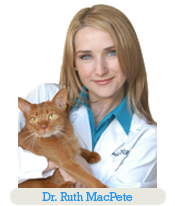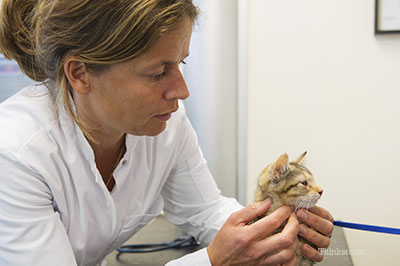

Although most people have never heard of it, feline eosinophilic complex is actually a relatively common skin disease that afflicts cats. Technically, eosinophilic granuloma complex refers to three related dermatological diseases: indolent ulcer, feline eosinophilic plaque, and feline eosinophilic granuloma. While each of these has a unique clinical appearance, they all share a characteristic microscopic appearance, as they are made up of eosinophils. In addition, all of these are common skin diseases seen in cats.
Feline eosinophilic complex can occur in all cats, of all breeds, all ages and both sexes.
Symptoms of feline eosinophilic complex
Since all of these conditions have their own presentations, I will discuss the symptoms and characteristics of each individually:
- Feline eosinophilic plaque: These appear as single or multiple lesions that are raised, red and may be ulcerated as well. While they can occur anywhere on the body, they are most often seen on the belly and back portion of cats’ thighs. The lesions are usually very itchy and cats will often lick them incessantly.
- Feline eosinophilic granuloma: There are two forms of eosinophilic granulomas in cats: cutaneous (meaning skin) and oral. The cutaneous form typically occurs as an isolated lesion that is raised, red, firm, linear and may be ulcerated. People often notice a hairless area and upon further inspection see a raised red lesion. Lesions can occur anywhere on the body but are most frequently found on the back of the thigh, the chin or the lip. When they occur on the lip, it appears swollen. The oral form of eosinophilic granulomas present as well-circumscribed firm masses or plaque like lesions on the tongue or roof of the mouth (palate).
- Indolent ulcer: Indolent ulcers most commonly occur on the upper lips of cats. The lesion starts as a small crater-like, erosive lesion that often enlarges without treatment. Cats with indolent ulcers can have small, barely noticeable lesions to large ulcerated lesions that disfigure the lips. Despite their often-angry looking appearance, indolent ulcers are usually not itchy or painful.
Causes of feline eosinophilic complex
All three variations of feline eosinophilic complex are believed to be caused by a hypersensitivity reaction, also known as an allergic reaction. This can be an allergy to fleas, food ingredients, pollen, dust, house mites or other environmental allergens (atopy).
Diagnosis of feline eosinophilic complex
Feline eosinophilic lesions are diagnosed based on physical examination findings and medical history. In addition, your veterinarian may recommend more testing to confirm the diagnosis and rule out other diseases like fungal infections or tumors. This may include getting cytology or a biopsy of a lesion. If your cat has a skin or oral lesion, don’t assume it is a feline eosinophilic granuloma or plaque. It is important to have your veterinarian examine your cat and make sure that it is not something else. For example, squamous cell carcinomas are common ulcerative tumors seen in the mouth of cats.
Treatment of feline eosinophilic complex
Treatment is aimed at causing the lesion to regress and at the same time addressing the underlying cause. For example, if your cat’s feline eosinophilic plaque is thought to be caused by flea allergies it’s imperative that your cat be treated for fleas and remains on year round flea protection. Failure to address and treat the underlying cause will typically lead to reoccurrence of lesions at some point in your cat’s life. Steroids are the most common treatment used to make the lesion disappear. If the lesions are infected, systemic antibiotics may also be needed.
Questions to ask your veterinarian:
- How long does it typically take for the lesions to go away after treatment?
- Are there any side effects of the treatment? What are they?
- When should I come in for a recheck?
If you have any questions or concerns, you should always visit or call your veterinarian -- they are your best resource to ensure the health and well-being of your pets.
